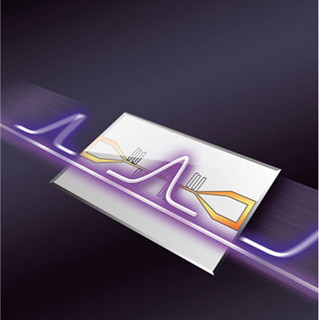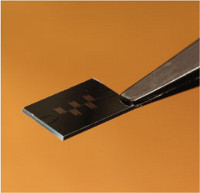Microwaves slowed down to pedestrian speeds
Nachrichten aus dem Physik-Department - 2013-02-01
Microwaves travel at the speed of light. Physicists in Garching and Lausanne couple superconducting microwave circuits with nanomechanical oscillators in order to control the propagation of microwaves. They achieve a dramatic slowing down.

In a collaboration with partners from the École Polytechnique Fédérale de Lausanne (EPFL) and the Max-Planck-Institute of Quantum Optics, researchers from the Walther-Meißner-Institut (WMI), Bayerische Akademie der Wissenschaften and Physik-Department, Technische Universität München, introduce a radically different approach to control the propagation of microwave signals.
The propagation of pulses of electromagnetic radiation is usually governed by the properties—such as dispersion—of the medium or waveguide that hosts the field. Now researchers have introduced a radically different approach to control the propagation of microwave signals. It harnesses the electromechanical interaction with the vibrations of a silicon nitride nano-string, and can be used to dynamically switch, slow down, and accelerate the propagation of microwave pulses. The signals can be retrieved after milliseconds’ of tunable delay, with negligible loss and distortion. A coaxial cable realizing the same delay would need to be 600 km long, thus very lossy, hardly tunable and expensive.
The teams around Tobias Kippenberg at EPFL and MPQ and Rudolf Gross at WMI and TUM are collaborating closely on the investigation of superconducting microwave circuits coupled to nanomechanical oscillators. These hybrid systems combine two platforms that have traditionally been studied in separate contexts: Superconducting microwave circuits are essentially printed circuit boards that operate at very high frequencies (10 GHz) and low temperatures (0.05 K above absolute zero). In recent years, these circuits have been established as one of the most promising candidates for future quantum information processors, due to their excellent coherence, operation speed and scalability. Nanomechanical oscillators, on the other hand, have been under physicists’ scrutiny for the yet unexplored quantum aspects of their vibrational motion, probing the laws of Quantum Mechanics in an unprecedentedly literal sense.
In their recent study, the Swiss-German team combined these two research endeavors in a quest for new, mechanical functionality for superconducting quantum circuits, but also potentially new handles on the nanomechanical oscillator’s properties provided by the microwave probe. As they report in an issue of Nature Physics, they could realize a coupling between the microwave field and the vibration of a nanomechanical string with a diameter of only 150 nm (a human hair is about 100-times larger) in an on-chip platform of finger nail size. The coupling proceeds by a tiny capacitance change in the circuit induced by the motion of the nanostring.
By analogy with phenomena known in atomic and optical physics, they found that the nanomechanical oscillator can mediate interference between microwaves, and exploited to control the propagation of microwave signals. In particular, they could create spectrally extremely sharp transmission windows (linewidth 10 Hz) for microwave radiation, which are accompanied by very long delays on the order of milliseconds. Thus, a microwave pulse takes the same time to travel across the microchip as if it was sent the 600 km from Garching to Lausanne at the speed of light.
Even more control by dynamically coupled second microwave field

Importantly, the width, delay, but also amplitude of the transmission window, i.e., the fraction of radiation power that is transmitted, can be dynamically controlled by a second microwave field. Using classical microwave pulses, the researchers have investigated these effects, and found a good agreement with their theory. They also addressed more subtle questions with regard to the possible temporal dynamics of the control that have been debated among experts, and found full agreement with their expectations. Another important result was that the system they implemented is capable of operating in a regime in which decoherence, a potentially detrimental effect for the processing of quantum information, is not a critical issue.
‘We developed a platform to manipulate wave propagation in a fully integrated architecture without the need of photon detection and regeneration. Its implications extend to the field of quantum computing and quantum information processing’ says Xiaoqing Zhou, the PhD student who developed the device in EPFL’s Center for Micronanotechnology (CMi).
‘Here, many approaches rely on on-chip quantum communication channels based on microwaves to which our findings can be directly applied’ sais Fredrik Hocke, the PhD student who realized the sensitive low-temperature measurement at WMI. Senior researcher Albert Schliesser comments ‘it is great to connect different fields of research. New results are often obtained at interfaces, such as here, between the Atomic Physics, Circuit Quantum Electrodynamics, and Nanomechanics field.’ Senior researcher Hans Huebl agrees,’I am sure this work will raise interest particularly in the electromechanics and superconducting quantum circuit community’. That given, the researchers already think about follow-up experiments involving more sophisticated superconducting circuits, which may allow preparing and manipulating the quantum state of the nanomechanical oscillator.
Journal article
Slowing, advancing and switching of microwave signals using circuit nanoelectromechanics
X. Zhou, F. Hocke, A. Schliesser, A. Marx, H. Huebl, R. Gross, and T. J. Kippenberg
Nature Physics (2013), doi:10.1038/nphys2528.
Acknowledgements
Financial support from the German Excellence Initiative through the Nanosystems Initiative Munich (NIM) is gratefully acknowledged. T.J.K. acknowledges support by the NCCR of Quantum Engineering, an ERC Starting Grant (SiMP) and the Swiss National Science Foundation (SNF). Samples were grown and fabricated at the Center of MicroNanotechnology (CMi) at EPFL, low temperature experiments and the development of experimental techniques have been done at Walther-Meißner-Institut. The authors acknowledge the assistance of S. Weis, T. Niemczyk and H. Chibani in fabrication, and P. Hakonen and P. Lähteenmäki for measurement in the early phase of the project.
Contact
- Dr. Hans Huebl Walther-Meißner-Institut, Bayerische Akademie der Wissenschaften und Physik-Department, TU München Tel.: +49 (0)89 / 289 –14311 E-Mail: Hans.Huebl@wmi.badw.de Web: http://www.wmi.badw-muenchen.de/
- Prof. Dr. Rudolf Gross Walther-Meißner-Institut, Bayerische Akademie der Wissenschaften und Physik-Department, TU München Tel.: +49 (0)89 / 289 –14201 E-Mail: Rudolf.Gross@wmi.badw.de Web: http://www.wmi.badw-muenchen.de/
Links
- Press release WMI
- Walther-Meißner-Institut (WMI), Bayerische Akademie der Wissenschaften, Garching
- École Polytechnique Fédérale de Lausanne (EPFL)
- Prof. Dr. Tobias Kippenberg
- Max-Planck-Institute of Quantum Optics, Garching
- Nanosystems Initiative Munich (NIM)